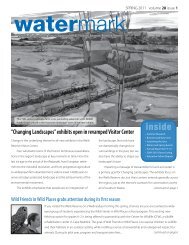Management Plan - National Estuarine Research Reserve System
Management Plan - National Estuarine Research Reserve System
Management Plan - National Estuarine Research Reserve System
Create successful ePaper yourself
Turn your PDF publications into a flip-book with our unique Google optimized e-Paper software.
and Tidal Marsh is the most common deposit typeat the <strong>Reserve</strong>.Soil formations in the <strong>Reserve</strong> tend to have gentleslopes, rapid permeability and slow surface runoff.Water tables are at or near the surface throughoutmost of the <strong>Reserve</strong>. Along the immediate coast,soils are generally deep sands (where beaches occur)or shallow sandy loams that are well to excessivelydrained, according the “Biophysical Regions ofMaine” report.Figure III.2. The Gulf of Maine stretches betweenCape Cod and southwestern Nova Scotia. Mapcourtesy of Gulf of Maine Council on the MarineEnvironment.and sandy beaches . The terrain is relatively flat,with elevations rarely rising above 100 feet—MountAgamenticus (which reaches an elevation of 691feet and is the highest point in the region) beingone of the exceptions.GeologyThe southern Maine landscape has been shaped primarilyby glaciation. During the last Ice Age, theLaurentide ice sheet covered the region, pressing onthe earth’s crust and causing land to subside. As glaciersmelted about 14,000 years ago, the land beganto rebound and the sea level rose. Coastal basins,embayments and watercourses have been formedover geologic time through interactions between sealevel and glacial movement. Meteorologic, hydrologicand oceanographic processes have contributedby scouring, eroding and transporting substratesinto today’s coastal configuration.Surficial geologic deposits at the Wells <strong>Reserve</strong>are strongly influenced by this geologic history.The <strong>Reserve</strong> has four deposit types: Swamp andTidal Marsh, composed of peat, silt, clay and sand;Glacial-Marine, composed of sand underlain bysilt and clay; Beach and Dune, composed of sand,gravel, and fine sediment, such as silt and clay; andGlacial Till, composed of sand and stones. SwampHydrologyThe Webhannet River watershed has a drainage areaof 8,964 acres (14 square miles), entirely within theTown of Wells. The Webhannet’s major tributariesare Depot Brook, Eldridge River and BlacksmithBrook (Figure III.3). Extensive wetlands and saltmarshes near the Webhannet River mouth emptyinto Wells Harbor, which flows to Wells Bay via adredged channel between two jetties.The Little River is formed by the confluence of theMerriland River and Branch Brook. Together, thethree waterways have a drainage area of 20,057acres (31 square miles). The Merriland River hasits headwaters in the City of Sanford and crossesthe Town of Wells. Branch Brook originatesfrom several springs near the Sanford municipalairport and serves as the border between thetowns of Kennebunk and Wells. The Kennebunk-Kennebunkport-Wells Water District draws publicwater from Branch Brook, reducing its flow to theLittle River. The Little River estuary flows to WellsBay via a salt marsh protected by an unarmoreddouble-spit barrier beach.The Ogunquit River watershed covers an area ofapproximately 13,300 acres (or 24 square miles) andis located in the towns of Wells, York, Ogunquitand South Berwick. Green Brook is a major tributary,with Tatnic Brook and several smaller tributariesconverging with the main stem of the river.The expansive salt marshes of the Moody Divisionof Rachel Carson <strong>National</strong> Wildlife Refuge arelocated behind a two-mile-long barrier beach and<strong>Management</strong> <strong>Plan</strong>: Setting19




